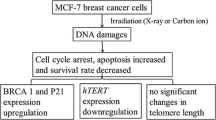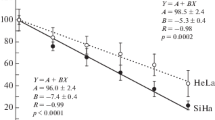Abstract
Purpose
The aim of this study was to clarify the radiosensitivity of intratumor total cells and quiescent (Q) cells in vivo to accelerated carbon ion beams compared with γ-ray irradiation.
Materials and methods
Squamous cell carcinoma (SCC) VII tumor-bearing mice received continuous administration of 5-bromo-2′-deoxyuridine (BrdU) to label all intratumor proliferating (P) cells. They then were exposed to carbon ions (290 MeV/u) or γ-rays. Immediately after and 12 h after irradiation, immunofluorescence staining for BrdU was used to assess the response of Q cells in terms of micronucleus frequency. The response of the total (P + Q) tumor cells was determined from the tumors not treated with BrdU.
Results
The apparent difference in radiosensitivity between total and Q cell populations under γ-ray irradiation was markedly reduced with carbon ion beams, especially with a higher linear energy transfer (LET) value. Clearer recovery in Q cells than in total cells through delayed assay under γ-ray irradiation was efficiently inhibited by carbon ion beams, especially those with a higher LET.
Conclusion
In terms of the tumor cell-killing effect as a whole, including intratumor Q cells, carbon ion beams, especially with higher LET values, were extremely useful for suppressing the dependence on the heterogeneity within solid tumors as well as depositing the radiation dose precisely.
Similar content being viewed by others
References
Schulz-Ertner D, Jaekel O, Schlegel W. Radiation therapy with charged particles. Semin Oncol 2006;16:249–259.
Todd P, Wood JC, Walker JT, Weiss SJ. Lethal, potentially lethal, and nonlethal damage induction by heavy ions in cultured human cells. Radiat Res 1985;8(suppl):S5–S12.
Blakely EA, Tobias CA, Yang TC, Smith KC, Lyman JT. Inactivation of human kidney cells by high-energy monoenergetic heavy-ion beams. Radiat Res 1979;80:122–160.
Palayoor ST, Humm JL, Atcher RW, Hines JJ, Macklis RM. G2M arrest and apoptosis in murine T lymphoma cells following exposure to 212Bi alpha particle irradiation. Nucl Med Biol 1993;20:795–805.
Kagawa K, Inoue T, Tokino T, Nakamura Y, Akiyama T. Overexpression of GML promotes radiation-induced cell cycle arrest and apoptosis. Biochem Biophys Res Commun 1997;241:481–485.
Vaupel P. Tumor microenvironmental physiology and its implications for radiation oncology. Semin Radiat Oncol 2004;14:197–275.
Masunaga S, Ono K. Significance of the response of quiescent cell populations within solid tumors in cancer therapy. J Radiat Res 2002;43:11–25.
Tsujii H, Mizoe JE, Kamada T, Baba M, Thuji H, Kato S, et al. Clinical results of carbon ion radiotherapy at NIRS. J Radiat Res 2007;48(suppl):A1–A13.
Masunaga S, Ono K, Suzuki M, Nishimura Y, Kinashi Y, Takagaki M, et al. Radiosensitization effect by combination with paclitaxel in vivo including the effect on intratumor quiescent cells. Int J Radiat Oncol Biol Phys 2001;50:1063–1072.
Torikoshi M, Minohara S, Kanematsu N, Komori M, Kanazawa M, Noda K, et al. Irradiation system for HIMAC. J Radiat Res 2007;48(suppl):A15–A25.
International Commision on radiation Units and Measurements. ICRU Report 58. Dose and volume specification for reporting interstitial therapy. Bethesda: ICRU; 1997.
Wu H, Hada M, Meador J, Hu X, Rusek A, Cucinotta FA. Induction of micronuclei in human fibroblast across the Bragg curve of energetic heavy ions. Radiat Res 2006;166:583–589.
Hall EJ. Linear energy transfer and relative biologic effectiveness. In: Hall EJ, editor. Radiobiology for the radiologist. 6th edition. Philadelphia: Lippincott Williams & Wilkins; 2006. p. 106–116.
Masunaga S, Ono K, Abe M. Potentially lethal damage repair by quiescent cells in murine solid tumors. Int J Radiat Oncol Biol Phys 1992;22:973–978.
Masunaga S, Ono K, Mitsumori M, Abe M. The alteration of radiosensitivity of quiescent cell populations in murine solid tumors irradiated twice at various intervals with X-rays. Jpn J Cancer Res 1993;84:1130–1135.
Author information
Authors and Affiliations
Corresponding author
About this article
Cite this article
Masunaga, Si., Ando, K., Uzawa, A. et al. Responses of total and quiescent cell populations in solid tumors to carbon ion beam irradiation (290 MeV/u) in vivo. Radiat Med 26, 270–277 (2008). https://doi.org/10.1007/s11604-008-0227-x
Received:
Accepted:
Published:
Issue Date:
DOI: https://doi.org/10.1007/s11604-008-0227-x




